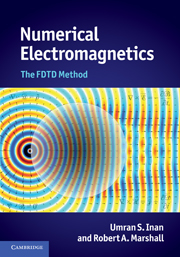Book contents
- Frontmatter
- Contents
- Preface
- 1 Introduction
- 2 Review of electromagnetic theory
- 3 Partial differential equations and physical systems
- 4 The FDTD grid and the Yee algorithm
- 5 Numerical stability of finite difference methods
- 6 Numerical dispersion and dissipation
- 7 Introduction of sources
- 8 Absorbing boundary conditions
- 9 The perfectly matched layer
- 10 FDTD modeling in dispersive media
- 11 FDTD modeling in anisotropic media
- 12 Some advanced topics
- 13 Unconditionally stable implicit FDTD methods
- 14 Finite difference frequency domain
- 15 Finite volume and finite element methods
- Index
13 - Unconditionally stable implicit FDTD methods
Published online by Cambridge University Press: 05 June 2012
- Frontmatter
- Contents
- Preface
- 1 Introduction
- 2 Review of electromagnetic theory
- 3 Partial differential equations and physical systems
- 4 The FDTD grid and the Yee algorithm
- 5 Numerical stability of finite difference methods
- 6 Numerical dispersion and dissipation
- 7 Introduction of sources
- 8 Absorbing boundary conditions
- 9 The perfectly matched layer
- 10 FDTD modeling in dispersive media
- 11 FDTD modeling in anisotropic media
- 12 Some advanced topics
- 13 Unconditionally stable implicit FDTD methods
- 14 Finite difference frequency domain
- 15 Finite volume and finite element methods
- Index
Summary
Until now, we have discussed the standard FDTD algorithm, based on the interleaved second-order centered difference evaluation of the time and space derivatives, as originally introduced by Yee in 1966 [1]. This method is an explicit method, in which the finite difference approximations of the partial derivatives in the PDE are evaluated at the time level (n + 1/2), so that the solution at the next time level (n + 1) can be expressed explicitly in terms of the known values of the quantities at time index n.
Explicit finite difference methods have many advantages. For the hyperbolic wave equation, an important advantage is the fact that numerical solutions obtained with the explicit method exhibit finite numerical propagation speed, closely matching the physical propagation speed inherent in the actual PDE. However, an important disadvantage of explicit methods is the fact that they are only conditionally stable. As a result, the allowable time step (vis-à-vis the CFL condition) is generally quite small, making certain types of problems prohibitive simply due to the enormous computation times required. In such cases, which include some important electromagnetic applications as discussed in [2], it is highly desirable to avoid the time step limitation.
Implicit finite difference methods provide the means with which this time step limitation can be avoided. With an implicit method, the finite difference approximations of the partial derivatives in the PDE are evaluated at the as-yet unknown time level (n + 1).
Information
- Type
- Chapter
- Information
- Numerical ElectromagneticsThe FDTD Method, pp. 327 - 341Publisher: Cambridge University PressPrint publication year: 2011
